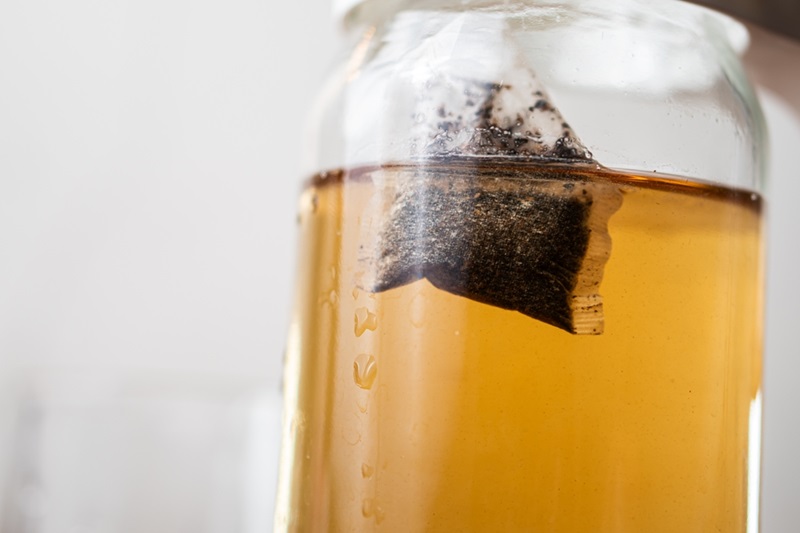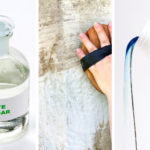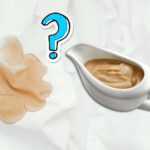It’s super kind, but annoying, when your dog decides to “help you” empty the cold teapot.
The teabags go flying, tea dregs splash against kitchen walls, and tannin taints the floor. It’s not ideal, but you’ve got to remain calm and say, ‘It’s okay, you’re a good girl!’ with a huge smile on your face.
The best thing to do is to get started on the cleaning! So, what’s the quickest and safest way to get tea stains off walls? Find out below.
Things to Know When Removing Tea Stains from Walls
- You must do a patch test with your chosen cleaning solution. A quick test will tell you if the product you plan on using will damage or discolour your wall. Based on the results of your patch test, you can continue using the solution or find something else.
- Don’t saturate your wall, especially if it’s got wallpaper on it. Only use damp cloths to clean the surface. And if you can’t wet the wall because it’s covered in a delicate type of wallpaper, stick to dry cleaning it!
- Allow the wall to dry. You can speed up this process by opening the window and placing a fan in the room. However, the wall shouldn’t be too wet anyway!
- Use neutral-coloured cloths to treat your wall so you don’t transfer any dye from your cloth to the surface.
- Respond and remove the tea stain quickly! The sooner you react and get rid of the stain, the less chance there is of it creating a more permanent eyesore on your wall. Remember, fresh stains are far easier to treat and eradicate in comparison to aged and dried-in ones.
- Don’t scrub the wall too hard because you will rub off the paint or scrub and rip the wallpaper. Stick to gentle movements.
- Assess what you’ve got on your wall (paint or wallpaper) and clean it accordingly. Failing to take note of what coverings you’ve got on your walls will lead to you ruining them.
- You’ll likely have to repeat your chosen cleaning method more than once to remove the entire tea blemish. Or you may have to swap between methods until you find the one that works for you.
Method 1: Washing Up Liquid
This method is suitable for papered and painted walls.
The easiest way to clear tea stains from a wall is to remove them using some warm, soapy water.
This is the quickest way to solve the issue and doesn’t involve using harsh chemicals! Plus, if you react fast, this may be the only method you’ll need to use.
Steps to follow:
- Fill a bowl with two cups of warm water.
- Add a blob or two of dye-free washing up liquid to the water.
- Stir the mixture with your hand.
- Dip a neutral-coloured microfibre cloth into the soapy water.
- Wring the cloth out – it must only be damp!
- Gently wipe the tea stain off the surface – wipe from top to bottom in strokes.
- Repeatedly soak, wring out the cloth and wipe the surface until it is clear.
- Use a dry, neutral-coloured cloth to wipe the surface dry.
Unfortunately, this method isn’t suitable for non-washable wallpapers like fabric ones that contain silk and velvet. To clean these kinds of wallpapers, you’ll need to dry-treat them. More on this below.
Method 2: Dry Cleaning
Some wallpapers, like those containing vinyl, have more moisture resistance than finer wallpapers containing materials that cannot withstand water. The manufacturer will state whether the wallpaper is washable.
If your tea-stained wallpaper cannot be cleaned with water, use a dry cleaning sponge to remove the tannin-filled eyesore. Simply wipe the wall in strokes from the top of the tea stain to the bottom.
It’s likely that you’ll have to repeat the steps above multiple times. However, don’t press down too hard because you could rip the paper.
Method 3: Magic Eraser
If you’ve got tea over a painted wall, you can clear the area using Method 1 above, then remove any remaining tannin stains by gently rubbing them away using a magic eraser, like Flash’s Ultra Power Magic Eraser. For tougher tea marks, try adding a little Cif to the surface and rubbing it in.
After treating the area, you can wipe it down using a damp, neutral-coloured microfibre cloth.
Note: This method works well on old, set-in tea stains that require more elbow grease and a more abrasive treatment.
Method 4: White Vinegar
This method is only suitable for painted and washable papered walls.
For tougher tea deposits, coat them in diluted white vinegar for a few minutes, then wipe them away.
Mix equal parts of white vinegar and water in a bowl, dip a cotton wool ball into the water, wring it out, then dab it onto the tea blemish. Wait five minutes, then clean the area using a damp, neutral-coloured cloth.
Method 5: Sugar Soap
This method is only suitable for washable papered and painted walls.
Sugar soap, like Everbuild’s Sugar Soap, is usually used to clean walls before they’re painted, but it can also remove ugly marks from the surface.
Dilute a measure of sugar soap in warm water (see instructions on the packaging for exact dose), then grab a neutral-coloured microfibre cloth, pop it in the liquid, wring it out and wipe the tea stain away – use smooth downward strokes.
When you’ve removed the mess, wipe the surface down with a damp, neutral-coloured cloth to remove the remaining product residue.
Method 6: Rubbing Alcohol or Hydrogen Peroxide
This method is only suitable for painted walls, and should only be used as a last resort.
Diluted rubbing alcohol or diluted hydrogen peroxide can be blotted onto a tea-stained wall to clear the blemish.
There is, however, a chance that these solutions may remove some paint from the wall in the process.
Simply pour a small amount of rubbing alcohol into a shallow dish, add water, dip a cotton wool ball into the solution, wring it out, and then dab it onto the tea stain.
Wait five minutes while the rubbing alcohol gets to work, and finally, rinse the area using a damp, neutral-coloured microfibre cloth.
Similarly, dilute a measure of 3% hydrogen peroxide in water (see instructions on the packaging for the exact dose) and start blotting the tea stain. When you’re done, rinse the area clean using lukewarm water.
Method 7: Patch Repair
You could do a patch repair on your stained wall as a last resort. For example, you could treat your painted wall using the steps above and then repaint the wall.
Or you could cut a chunk of wallpaper out and replace it with a fresh piece.
These aren’t necessarily the best options, but you should consider them, especially if you’re having difficulty removing the tea stain from your wall.
When Should You Call a Professional?
A wall stained with tea is unsightly, to say the least. However, it’s unlikely that you will need to ask a professional cleaner or, painter and decorator to come over to help you sort out the issue. You should be able to cure the problem yourself and for very little cost.
Of course, if you’ve got a large-scale issue, say years and years’ worth of tea, amongst other things, have stained your walls, then it may be a good idea to call a professional for help.
But as noted, if you’ve only got minor tea marks, you should be able to remove them with ease yourself.
How to Avoid Getting Tea Stains on Walls
Your walls will inevitably get sloshed with liquid at some stage. It’s not something you can really avoid.
There are, however, ways to reduce the chances of your walls getting tainted. These include:
- Ensure cups are positioned away from walls, so there’s less risk of the surface getting splashed. For example, place the cup on a coffee table away from the wall.
- Protect mugs when they’re filled with tea. For example, don’t put the mug on the floor where someone could trip and knock it over.
- Empty teapots out before you tip the teapot upside down.
- Be careful. Don’t rush when you’re handling tea, teabags and teapots.
- Squeeze teabags so they don’t contain too much moisture.
- Mop up spillages quickly.
- Keep the tea contained in one area. If you’re very worried, have a ‘no drinks policy’ in certain areas of the home.
- Don’t fill mugs up too full.

Bethan has a passion for exploring, reading, cooking and gardening! When she’s not creating culinary delights for her family, she’s concocting potions to keep her house clean!






